
The weekly U.S. Drought Monitor report, produced by the National Drought Mitigation Center at the University of Nebraska-Lincoln, the United States Department of Agriculture and the National Oceanic and Atmospheric Administration, shows the drought situation across the Midwest and High Plains has continued to deteriorate over the past week, despite cooler-than-normal temperatures from September 3 to 10. According to the latest drought summary, large areas of the Midwest, including Kentucky, southern Illinois, eastern Missouri, and parts of Indiana, have seen significant expansions of moderate drought conditions. Meanwhile, the High Plains experienced mixed results, with improvements in some areas but growing dryness elsewhere.
Midwest sees widespread dryness
The Midwest remained largely dry throughout the past week, with only a few areas, including eastern Ohio and Michigan’s Upper Peninsula, seeing any notable precipitation. Temperatures were 2 to 6 degrees below normal, providing some respite from the summer’s intense heat. However, the lack of rainfall led to continued deterioration of soil moisture, particularly in Kentucky, eastern Missouri, and southern Illinois. These regions saw one-category expansions of abnormal dryness and moderate drought, with signs of deeper-level soil drying.
Western Ohio also experienced worsening drought conditions, particularly in areas along the Ohio River, where exceptional drought has expanded. The dry conditions are now prevalent across most of the Midwest, with many cities having recorded one of their hottest summers on record.
High Plains: mixed results, but dryness persists
The High Plains region saw both improvements and worsening conditions. While higher elevations in Colorado and Wyoming received some much-needed precipitation, much of the region, including Kansas and Nebraska, remained dry. Kansas experienced patchy rainfall from isolated thunderstorms, but drought conditions continued to expand, particularly along the western, southern, and eastern borders of the state.
Eastern Colorado is showing signs of prolonged dryness, with moderate drought conditions creeping further eastward from the Kansas border. In Wyoming, central and northern areas are also experiencing drier conditions, with soil moisture levels decreasing in the short term.
Agricultural impacts
Farmers across the Midwest and High Plains are bracing for further challenges as the drought intensifies. The lack of rainfall is threatening crop yields, particularly for corn and soybeans, as moisture levels in the soil continue to drop. The deteriorating conditions could impact the harvest season, putting additional pressure on an already stressed agricultural sector.
Looking ahead
The forecast for the next five days (September 11-16) does not offer much hope for relief. While precipitation is expected in the high elevations of Montana and Idaho, as well as parts of southern Arizona, the Midwest and High Plains are likely to remain dry. The National Weather Service’s 6-10 day outlook predicts above-normal temperatures across much of the Midwest, including Minnesota, Wisconsin, and Michigan, with a continued lean toward below-normal precipitation in the Great Lakes region and parts of the High Plains.
With little rainfall expected and the risk of worsening drought conditions, farmers and communities across the Midwest and High Plains are preparing for a challenging fall season.

















